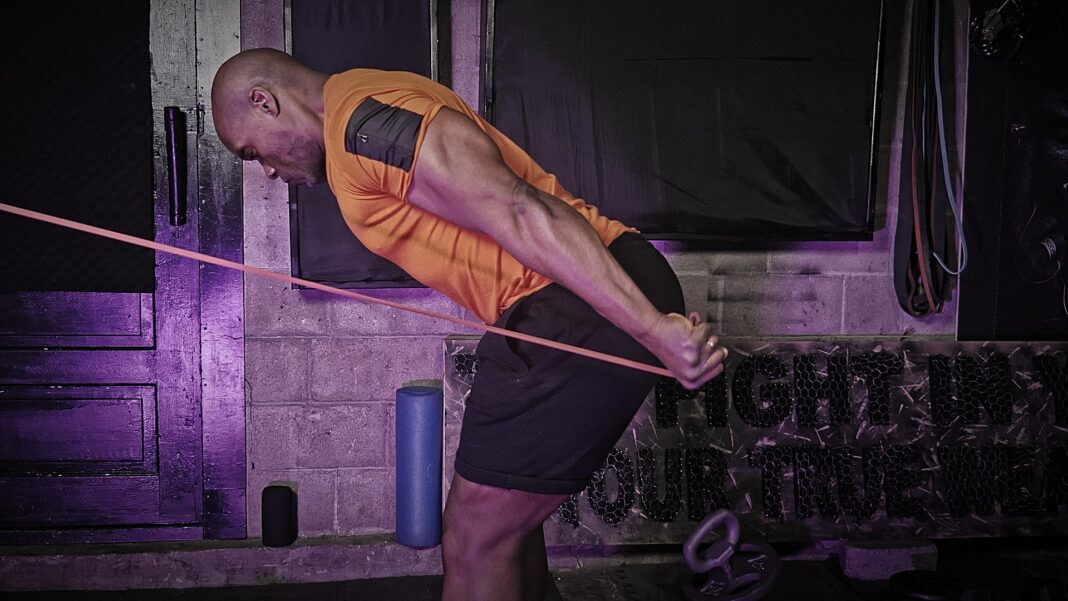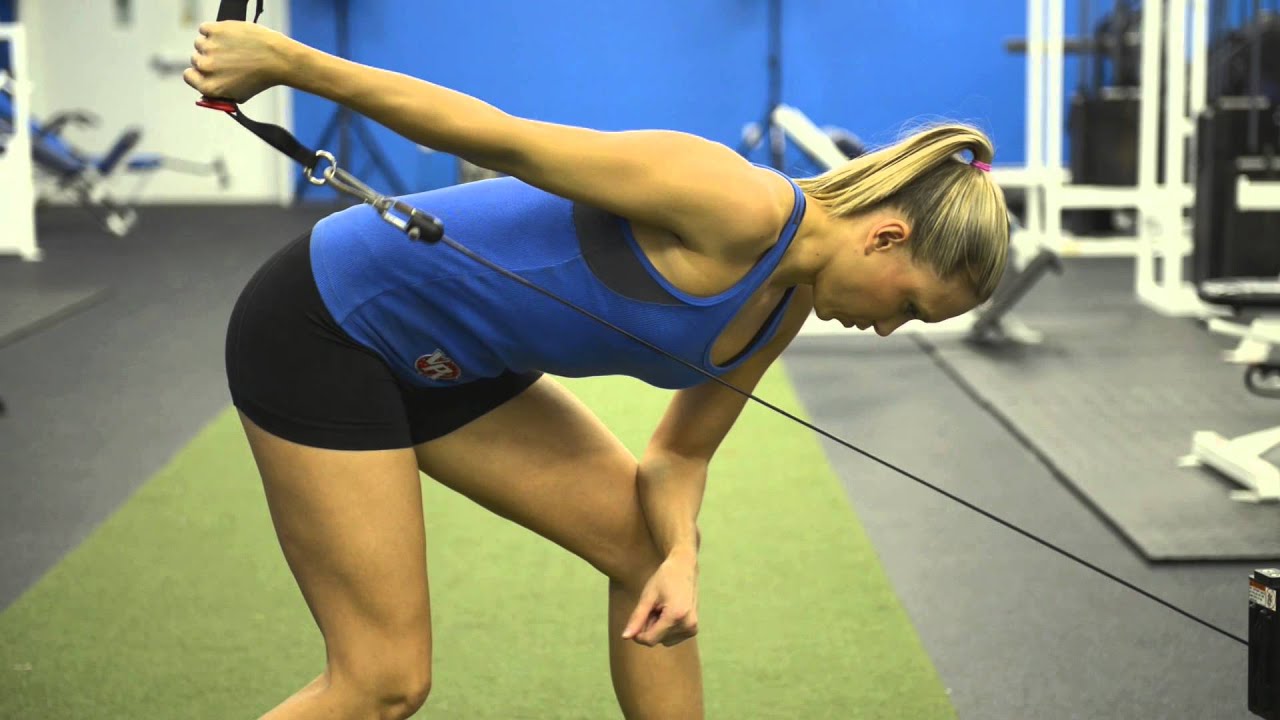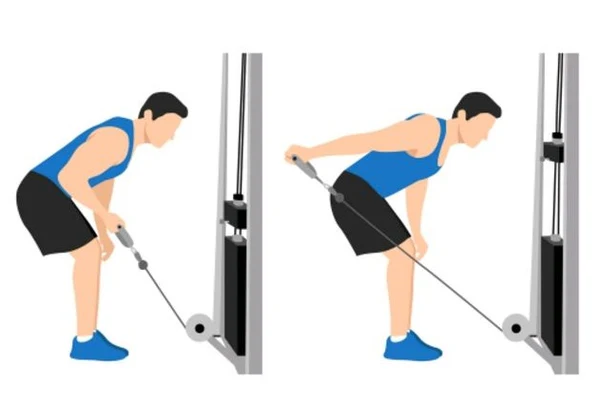Cable Kickback (Triceps Focus): The Constant-Tension Finisher for Sculpted Arms
If the dumbbell kickback is the classic triceps isolation move, then the cable kickback is its smarter, smoother, and more effective evolution.
While dumbbells rely on gravity — losing tension at the top of the rep — the cable machine delivers constant tension throughout the entire range of motion, making it a superior tool for mind-muscle connection and finishing detail.
The Cable Kickback is one of the most precise isolation movements for triceps development, particularly for the lateral head and long head. It’s the movement bodybuilders turn to when they’re refining shape, separation, and hardness at the end of a push or arm day.
When performed with control and intent, it lights up the triceps in a way few other exercises can — giving that dense, sculpted look that finishes a well-built arm.
Muscles Worked
Primary Muscles:
- Triceps brachii (lateral and long heads emphasized)
Secondary Muscles:
- Deltoids (rear for stabilization)
- Core (for posture control)
💡 Anatomical insight:
While all three triceps heads engage, the lateral head bears the most tension when the arm is fully extended backward. The cable’s constant pull ensures activation remains steady from start to finish — perfect for hypertrophy.
Why Bodybuilders Use It
- Constant Tension Advantage
- Cables maintain resistance through the entire rep — no dead zones.
- Precision Isolation
- Ideal for shape and detail work at the end of a triceps workout.
- Joint-Friendly Movement
- Smooth resistance minimizes elbow stress compared to free weights.
- Perfect for Mind-Muscle Connection
- The slow, controlled tempo encourages maximum contraction focus.
- Versatile Angles
- Can be performed standing, kneeling, or bent over with different handles.
Step-by-Step Technique
Setup
- Attach a single-handle grip to a low pulley on a cable station.
- Stand beside the pulley and grasp the handle with one hand using an overhand (neutral) grip.
- Hinge slightly forward at the hips with a flat back and soft knees.
- Pull your upper arm close to your torso, elbow bent at 90°. This is your starting position.
Execution
- Contraction (Extension) Phase
- Exhale as you extend your elbow, pushing the cable handle backward until your arm is straight.
- Keep your upper arm fixed against your side — only your forearm should move.
- Squeeze your triceps hard at full extension for 1–2 seconds.
- Return (Eccentric) Phase
- Inhale and slowly bend your elbow, returning the handle to the starting position.
- Maintain constant tension — do not let the cable snap forward.
- Tempo
- Extend: 1–2 seconds
- Squeeze: 1 second
- Return: 2–3 seconds
Key Form Cues
✅ Keep elbow high and fixed — don’t let it drop during the movement.
✅ Hinge forward enough to keep the cable line in alignment with your forearm.
✅ Focus on squeezing the triceps, not swinging the arm.
✅ Maintain constant tension — never rest at the top or bottom.
✅ Keep your wrist neutral to avoid strain.
Common Mistakes and Fixes
| Mistake | Problem | Fix |
| Dropping the elbow | Shifts tension away from triceps | Keep elbow pinned against your torso |
| Using momentum | Reduces muscle activation | Slow down, control each phase |
| Short range of motion | Limits contraction | Fully extend without locking out |
| Letting cable snap forward | Loses tension, risks injury | Control the eccentric |
| Excessive torso movement | Poor isolation | Brace core, stay stable |
Variations and Alternatives
- Standing Cable Kickback
- Classic version with a forward lean — emphasizes long head engagement.
- Kneeling Cable Kickback
- Adds core stability and isolates the working arm more effectively.
- Double-Arm Cable Kickback
- Both arms simultaneously — efficient but slightly less focus per side.
- Rope Attachment Kickback
- Allows a neutral grip and greater range for triceps contraction.
- Reverse-Grip Kickback
- Supinated grip targets the medial head more intensely.
- Cross-Cable Kickback
- Standing in the middle of a dual cable station — smooth resistance curve and balance between arms.
Programming and Rep Schemes
For Hypertrophy
- Sets: 3–4
- Reps: 12–15
- Rest: 60–90 seconds
- Focus: Controlled movement, full contraction
For Endurance / Definition
- Sets: 2–3
- Reps: 15–20
- Rest: 30–60 seconds
- Focus: Continuous tension and pump
For Strength Maintenance (Accessory Phase)
- Sets: 3
- Reps: 8–10
- Rest: 90 seconds
- Focus: Moderate weight, slower tempo
Where to Place It in a Workout
Example Arm Day
- Close-Grip Bench Press – 4×8
- Skullcrusher – 3×10
- Rope Pushdown – 3×12
- Cable Kickback – 3×15 (each arm)
Example Push Day
- Overhead Press – 4×6
- Dips – 3×10
- Cable Kickback – 3×12–15 (finisher)
- Lateral Raises – 3×15
Example Home-Friendly Cable Circuit
- Rope Pushdowns – 12 reps
- Overhead Rope Extensions – 12 reps
- Cable Kickbacks – 15 reps each arm
(Repeat 3–4 rounds with minimal rest)
Advanced Training Strategies
- Slow Negatives
- 3–4 seconds lowering per rep — enhances time under tension and fiber recruitment.
- Drop Sets
- Perform 10 reps, reduce the weight by 20%, and immediately complete another 10–12.
- One-and-a-Half Reps
- Extend fully, lower halfway, extend again — increases intensity within each rep.
- Superset Pairing
- Pair with heavier compounds (like close-grip presses or dips) to maximize fatigue.
- Mind-Muscle Connection Work
- Perform with lighter weight and laser focus on the squeeze — perfect as a finisher.
Safety Tips
⚠️ Warm up your elbows and shoulders before isolation work — especially if you’ve done heavy presses.
⚠️ Avoid jerking the cable — it can strain the elbow joint.
⚠️ Choose proper alignment — handle height should match your forearm angle.
⚠️ Don’t overload — the goal is control, not brute strength.
Bodybuilder’s Perspective
💡 Dorian Yates and Frank Zane both incorporated cable movements to refine triceps separation late in prep phases.
💡 The constant tension of cables enhances metabolic stress, one of the key hypertrophy mechanisms.
💡 Because the cable keeps your triceps under load even at the top of the rep, it’s ideal for blood flow–restricted (BFR) work in advanced phases.
💡 Use this as your final exercise on triceps day to flush the muscle and finish strong.
Strength vs Aesthetic Goals
| Goal | Rep Range | Benefit |
| Mass/Hypertrophy | 10–15 | Deep fiber fatigue under constant tension |
| Definition/Shape | 15–20 | High pump, improved separation |
| Symmetry | Unilateral control | Balanced arm development |
Comparison: Dumbbell vs Cable Kickback
| Feature | Dumbbell Kickback | Cable Kickback |
| Tension Curve | Drops at top | Constant throughout |
| Control | Gravity-dependent | Smooth cable resistance |
| Joint Safety | Can strain elbow | Smoother and safer |
| Isolation Quality | Good | Excellent |
| Best For | Beginners | Intermediate → Advanced bodybuilders |
Practical Takeaways
✅ Focus on slow, strict form — tension is everything here.
✅ Keep the elbow fixed and upper arm steady.
✅ Use moderate resistance — if you’re swinging, it’s too heavy.
✅ Pair it with pushdowns or overhead extensions for complete triceps work.
✅ Finish your triceps session with it to maximize the pump and definition.
Conclusion
The Cable Kickback is one of the most underrated — yet most effective — triceps isolation movements for sculpting dense, defined arms. By maintaining constant tension and perfect control, it targets the triceps through its full range, carving the shape that separates a good arm from a great one.
For physique-focused lifters, this is your triceps detail weapon. It doesn’t build raw pressing power like close-grip benches or dips — it builds precision, separation, and shape.
Train it slow, squeeze every rep, and watch your triceps take on that crisp, three-dimensional look that turns heads onstage and in the gym.
Cables don’t lie — every inch of movement counts.






